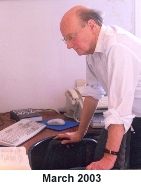|
||||
|
Home
| Kurt
Weill | Editions, Arrangements and Translations by David
Drew | |
||||
Weill: A Life and Works (unpublished typescript) This was the working title of a 950,000-word typescript written between1958 and1976 for publication in the UK (Faber & Faber) and the USA. The typescript - already in third draft and provisionally arranged in three volumes - was withdrawn in 1976 pending a solution of copyright problems, and subsequently set aside for review at some appropriate date. In response to active interest from a leading American publisher in the early 1990s, a revised text of one of the volumes was offered for publication, and in principle accepted on the basis of two recommendations, pending completion of the revision. Rather than continue revising, the author made an entirely new start in 1998: Weill at 25 replaces part of the first volume of the "Life and Works" - which is now definitively withdrawn. It's hoped that a few sections of the later volumes can still be salvaged. 
Über Kurt Weill (1975) A selection from the most important articles, essays, reviews and polemics published in the composer's lifetime, with an extensive Introduction by the editor (an English version of which was published in the Times Literary Supplement). The volume was published early in 1975 as Nr.237 in the suhrkamp taschenbuch series. Kurt Weill, Ausgewählte Schriften (1975) 
This first-ever selection of the composer's writings - with an Introduction and notes by the editor - was published in the summer of 1975 as Nr.285 in the suhrkamp taschenbuch series, together with its companion volume No.237. The two volumes were intended to mark the 75th anniversary of the composer's birth and the 25th of his death. Unlike No.237, which has had no successors (but is long out of print), 285 has been superseded by more recent publications - definitively, by the 'Gesammelte Schriften', published in 2000 by Schott, and edited by Stephen Hinton and Jürgen Schebera. However, both the main body of the text and the end-notes contain material not readily accessible elsewhere. 
Originally commissioned by the Academy of Arts in West Berlin as a catalogue of the papers and manuscripts in the Weill legacy, the Handbook became a much more ambitious undertaking, and was intended to provide a panoramic view of Weill's working life that would include not only his finished works and uncompleted or surviving fragments, but also a consideration of unrealised projects, and such peripheral matters as the character and significance of the composer's library of music and books. Its British and American editions (Faber, and the University of California Press, respectively) were well received. The proposed paperback edition which had been part of the publishing plan, was however postponed at the author's request. In view of subsequent developments and massive research by European and American scholars, any update of the original edition - though desirable in principle - would now be a major undertaking. In Preparation Weill at
25 
Kurt Weill was born on 2 March 1900, and died on 3 April 1950. His centenary in the year of the New Millennium was the occasion for worldwide celebrations, for many important publications, and for innumerable performances or hearings of his music. It was a fitting reward for more than a decade of assiduous and imaginative work by new generations of Weill specialists on both sides of the Atlantic. Weill at 25 belongs to the reflective aftermath. The central section of it was written in London between early August 2000 and October 2001. It is the author's first book-length study of any aspect of Weill since the publication in 1987 of his Kurt Weill: A Handbook, and is likewise addressed to a broad spectrum of readers. The questions Weill at 25 asks of its subject, as composer and as human being, are those that every traveller is accustomed to: who are you? where do you come from? and where are you going? The answers are sought from his letters, his writings, and above all his music. In the second half of his 25th year Kurt Weill was largely occupied with the writing of his one-act opera The Protagonist - based on the play of the same name by Georg Kaiser (with whom he had already collaborated on an piece intended for the dance theatre). He finished the draft in December 1924, and the definitive score in March of the following year - around the time of his 25th birthday. Two months later he began a new life (or at least a new way of life) together with the actress and dancer Lotte Lenya. He had met her through Kaiser the previous summer, and by the early winter was already passionately involved with her. They were to marry in January 1926, two months before the highly successful premiere of The Protagonist. Weill at 25 is an exploration whose circular and arc-like structures are oriented towards the destinations as well as the origins of the composer's many and various quests. The Protagonist is at the centre, but never alone there. The operatic past is part of the scenery from the start. References to the composer's own later works begin to proliferate, until eventually, The Protagonist is revealed within the same perspective as Street Scene (1947). Two stage works that might otherwise seem to be diametrical opposites are thus brought together: the experimental Expressionist opera that made Weill's name as an opera composer in Germany, and the equally experimental opera-for-Broadway which the composer regarded as the fulfillment of a lifelong ambition (and is today one of the most widely appreciated of all his works). The Protagonist ends in darkness, at the edge of an abyss. But the 25-year-old Weill is immensely hopeful, radiantly happy, and (it seems) entirely forward-looking. The ties of family are loosened but not broken; those of formal religion survive only - if at all - in the cycle of the Jewish year; yet the problems of faith and its loss are not casually brushed aside. Like the composer himself, Weill at 25 looks forward to the premiere of The Protagonist in March 1926, and some way beyond it. The closing section is no mere epilogue. It begins with a survey of Weill's collaboration with Kaiser's friend Yvan Goll, the Franco-German poet and playwright. Their opera-ballet Royal Palace was intended (with Kaiser's blessing) as a companion-piece for The Protagonist, but never performed as such. Only briefly rescued from oblivion by a Holland Festival performance in the early 1970s, Royal Palace at long last came into its own as a result of a much-acclaimed concert performance mounted by the BBC in January 2000 and repeated at the BBC Proms in 2001. The third of the early one-act operas, The Tsar has his Photograph Taken was successful from the start, and successfully revived in the 1960s and 1970s, but has recently fallen from critical and public favour. Drew suggests some reasons for reconsidering it. Although self-contained as an introduction to the composer and his works, Weill at 25 may also serve as an introduction to the author's forthcoming and projected study, Kurt Weill and the Cities of the Plain. It therefore opens with a double Prologue, in which Weill's life and music before The Protagonist are reviewed in the context of his own self-appraisals towards the end of his life. Implicit in the title and manifest at various points is the long-term plan for a concluding volume entitled Weill at 50. Kurt Weill and the Cities of the Plain (working title) Vol. I: From the Rise
of Mahagonny to the Wall Street Crash (1927-29) Weill at 50 |
||||
|
|
||||
|
Material Copyright © 2002 David Drew. |
||||
